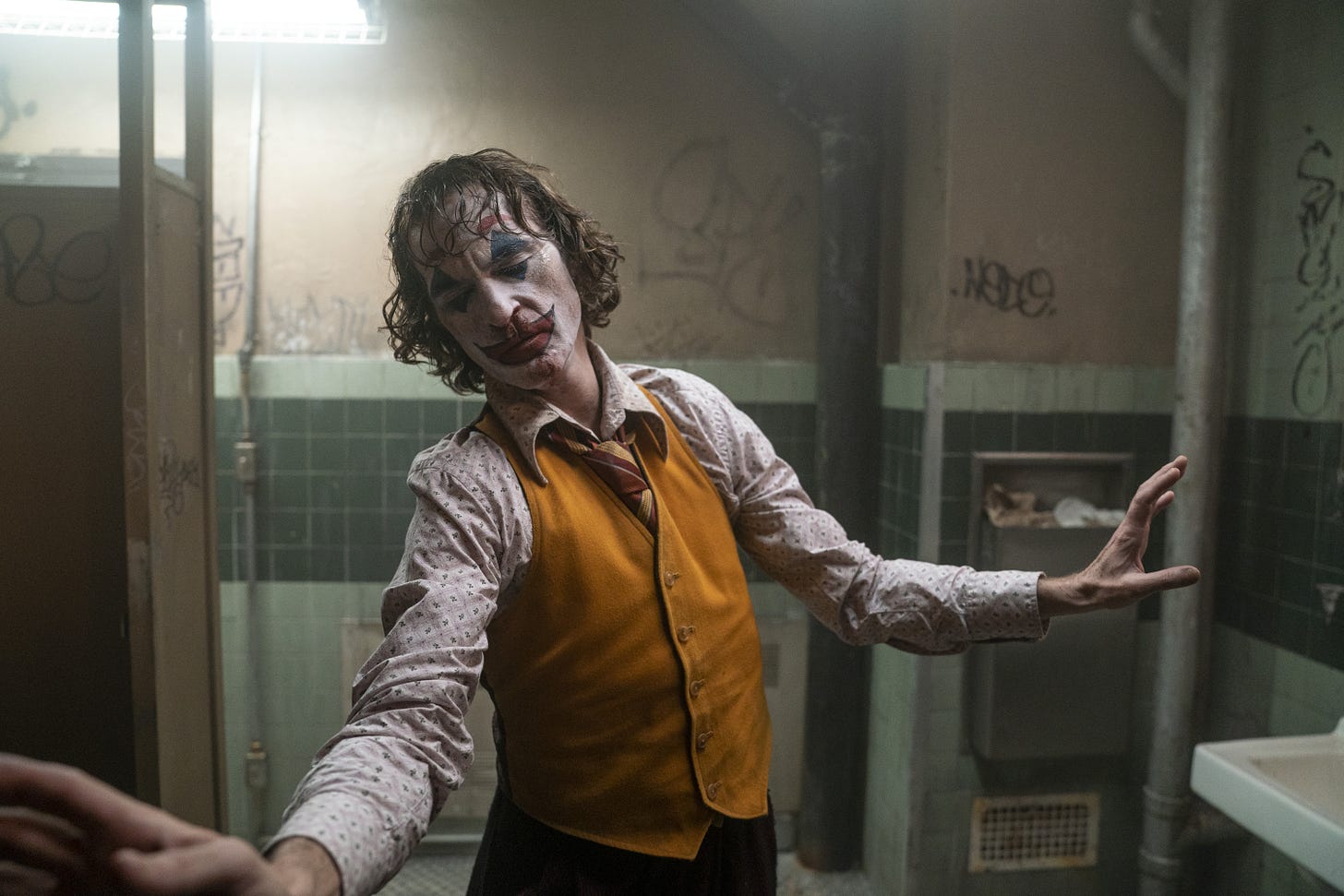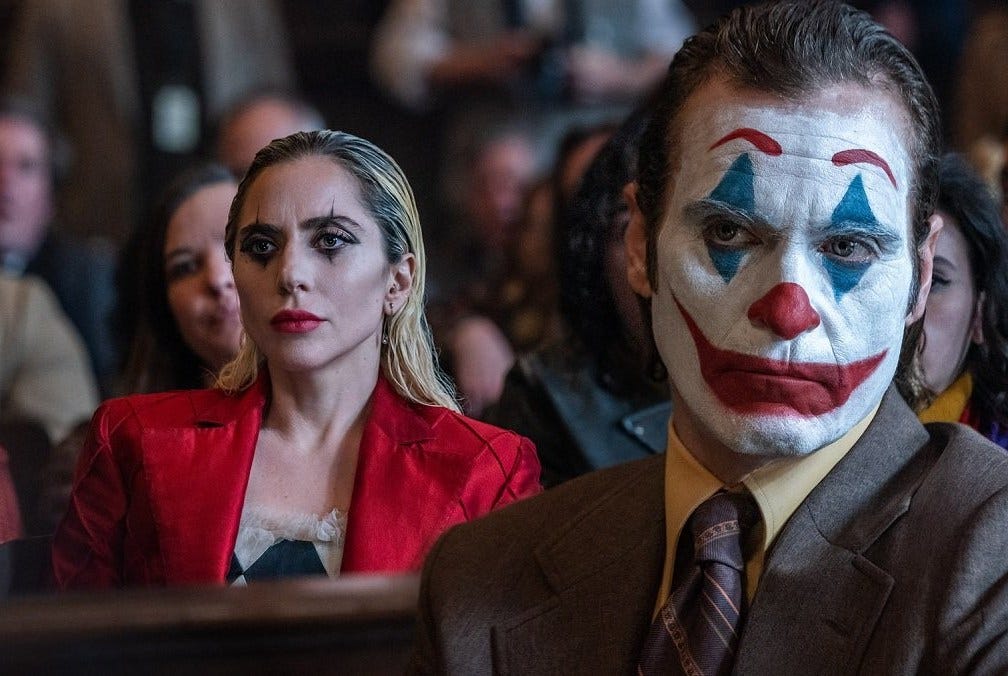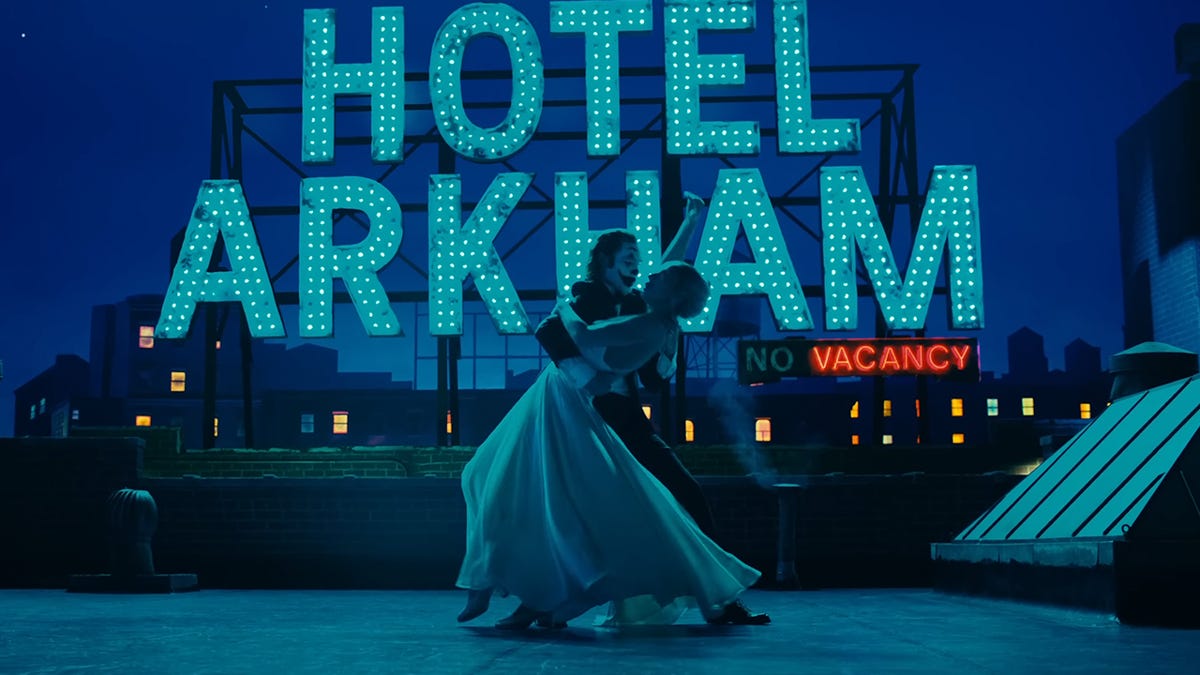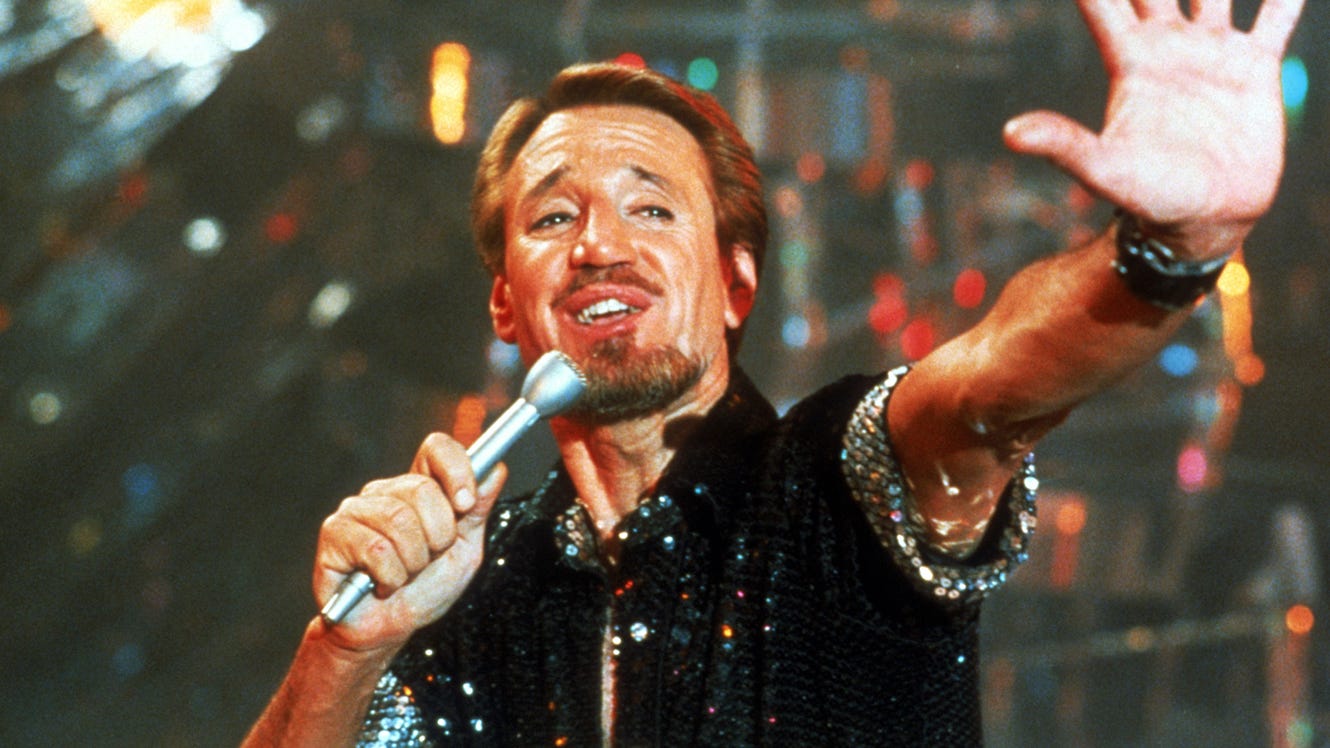In (Mild) Praise of Joker: Folie à Deux
The DC sequel is a critically reviled box office flop. But it's a bold genre experiment that's well worth a watch.
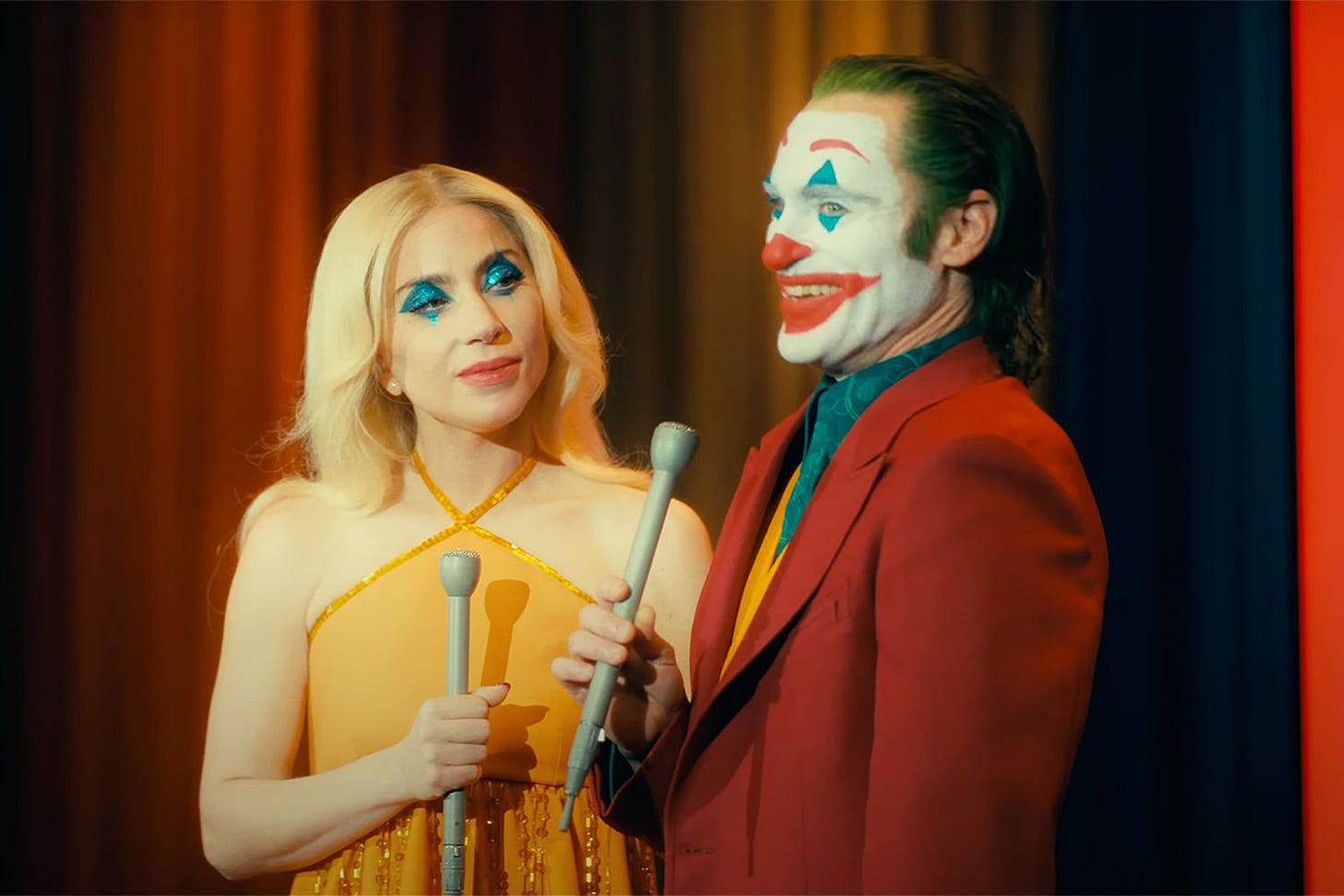
Joker: Folie à Deux, the recently-released sequel to 2019’s Joker, is, by just about every measure, a flop. Its critical reception has been icy, and its audience reactions even worse. While its predecessor pulled in over a billion dollars, director Todd Phillips’s sequel has already crashed and burned at the box office and has been punted to digital on-demand viewing. All that is to say, when I went to see it, I expected an unmitigated disaster, especially considering I wasn’t particularly fond of the original. Instead, when the credits rolled, and the group of friends I had gone with were reacting with awed disdain, I was shocked by how much I enjoyed the film. Though it’s not without its issues, Joker: Folie à Deux is a far better film than its reputation and one that does truly fascinating work with the genre and media landscape in which it exists.
The original Joker received a positive reception overall – it sits at a healthy 68% on Rotten Tomatoes, was nominated for 11 Academy Awards, including Best Picture, and won two, Best Actor for Joaquin Phoenix as protagonist Arthur Fleck and Best Original Score for Hildur Guðnadóttir’s tense, string-heavy compositions. Despite being generally well-liked, there was, certainly, a strong current of backlash.
Amidst the Trump-era culture war malaise of its 2019 release, the film’s depiction of a downtrodden, socially isolated white man being driven to violence was interpreted by some as an endorsement of “incel” ideology, and even a call to real-world violence. Upon Joker’s release, armed police units patrolled some theaters, and friends of mine faced calls from parents to avoid the movie, out of fear that a mass shooter would target a screening. With five years of hindsight, we can view this panic as unfounded and hyperbolic, and perhaps even realize that it, in part, may have helped the film, giving it a sense of danger and controversy, propelling it to the forefront of the zeitgeist.
On the more evenhanded side of things, critics had plenty to laud and decry about the original Joker. Phoenix’s tortured, transformative performance was widely praised, though it had detractors who found it overwrought. The film was inarguably well-constructed, with Lawrence Sher’s cinematography capturing a rain-slick Gotham reminiscent of decaying 1970s New York City. Simultaneously, the main point against Joker was the charge of unoriginality– not for its drawing from DC Comics and the world of Batman, with which it shares only the lightest superficial similarity, but from the films of Martin Scorsese, in particular, Taxi Driver and The King of Comedy. Indeed, the film’s narrative, of a mentally ill urban loner driven to violence through obsession with a talk show host bears more than a little resemblance to Scorsese’s films.
Ultimately, my greatest qualm with Joker was that, despite its bracing subject matter, it feels as though Phillips is unsure of what he wants to say about his protagonist. When Arthur turns to homicidal violence, is he a tragic figure, driven to monstrosity by a monstrous society? Or is he a twisted hero, righteously standing up against a world that has beaten him down? I’m far from a prude and love many morally dubious protagonists, but Joker feels too ultimately indecisive, leaving viewers emotionally adrift. It’s for this reason that the film, despite its sharp subject matter, failed to move me.
It’s this reckoning with a major weakness of the first film that makes Folie à Deux a fascinating, even superior sequel. The first Joker was intended as a standalone film and didn’t leave an obvious direction for a sequel to take. Rather than continue Arthur’s development into the clown prince of crime many Batman fans expected him to become, Phillips forces him and the audience to reflect on the true consequences of the first film as Arthur is put on trial for his crimes, revealing him instead as a deeply broken man, not a supervillain.
Indeed, those fans who itched to see Phoenix fully embody the sinister clown tormentor of the Dark Knight might find themselves at odds with the themes of Folie à Deux. Phillips tackles toxic fandom in a way that the film’s detractors have labeled as a hatred for his audience. Whether Phillips dislikes you, the viewer personally, or not, it’s clear that he wants to refute those who viewed Arthur as a hero– and perhaps even regrets depicting him in a way that could be understood as such; Arthur’s trial is a thorough dressing-down of the protagonist.
The testimony of Arthur’s former fellow party clown Gary Puddles (Leigh Gill) is a particularly effective sequence. In the first film, Arthur brutally stabbed a bullying coworker to death but spared the life of Gary, the sole witness, all the while mocking his dwarfism-related short stature As Gary testifies about how witnessing Arthur’s violence has traumatized him, Gill’s performance is genuinely touching, an emotionally raw, down-to-earth piece of acting in a film that largely deals in broad strokes.
Lady Gaga’s inclusion as Harleen “Lee” Quinzel, a dramatic reimagining of the beloved Harley Quinn character, is the film’s most fascinating choice. In most depictions of the character, Harleen Quinzel is a straight-laced psychiatrist who finds herself seduced and corrupted into villainy upon taking on the Joker as a patient. Phillips inverts this dynamic– instead, Gaga’s Lee is a corrupting influence on Arthur, an obsessed fan who voluntarily checked into Arkham State Hospital to get closer to her idol. Arthur expresses a desire to heal and move on from his crimes, while Lee admires his villainous actions and implores him to return to the persona of Joker. The villain of the Joker sequel, in other words, is everyone who wanted a Joker sequel that just dealt out more of the first.
It’s also through Lee that Phillips introduces perhaps the most contentious element of Folie à Deux: its musical elements. Some of the film’s critics are the musical-averse, repelled by a film with song-and-dance numbers. Yet others are devotees of musical theater, who argue that the film’s musical numbers aren’t committed and theatrical enough. I lean slightly towards the latter camp, as I do wish fewer of the film’s songs– nearly all preexisting mid-century show tunes– were performed as mellow, half-spoken-half-sung numbers. But many songs, which stand out as highlights of the film, take place in a colorful dreamscape, blending talk show sets, bandstands, and rooftops in a swirl of Technicolor that stands in dynamic contrast with the film’s dark, dreary real-world scenes.
I’ve endeavored to keep this review mostly spoiler-free, but a crucial aspect of what worked for me about Folie à Deux is in what it does in its final sequences, so major spoilers ahead. If you’d like to remain in the dark about how the film ends, skip to the end of this article.
Spoilers ahead
The film’s final act goes thusly: Arthur is found guilty of murder in his trial, but before the verdict is complete, a car bomb set off by one of his supporters blows through the courthouse walls. Arthur escapes and is whisked away in a car by another man dressed as the Joker. Arthur, though, finds himself repelled by his supporters, and flees, eventually returning to the vertiginous staircase where he famously danced in the first film. He meets Lee, who rejects him for giving up the Joker persona. In this moment, Phillips inverts the iconography of the first film, staging Arthur’s descent to and ascent from villainy in the same location, the former being a bold moment centered on music and dance, the latter being a low-key character moment. Arthur is apprehended and returned to Arkham.
The next day, a young prisoner, apparently inspired by Arthur’s actions as the Joker, stabs Arthur to death. As he bleeds out on the floor, we hear the young inmate laughing maniacally and carving a smile into his face, implying he may be the “true” Joker. As Arthur’s consciousness fades, we cut to a dreamscape musical sequence, before cutting back to his corpse as the credits roll.
With this final image, everything Phillips was doing clicked into place for me. If Joker was a riff on Taxi Driver, Folie à Deux may just be his attempt at All That Jazz, the 1979 musical self-portrait directed by Bob Fosse and starring Roy Scheider as a lightly fictionalized version of Fosse named Joe Gideon. Like Folie à Deux, Fosse’s film is an interrogation of its deeply flawed protagonist and those who admire and enable him, presenting him with characters who question his morality all the while alternating between grounded reality and expressionist musical dreamscape performances of older show tunes. In both films, the protagonist dies before he can atone for his sins, his death expressed as a grand musical number– before concluding on a stark image of his dead body.
Of course, even as someone who enjoyed the film, Folie à Deux is no All That Jazz. Arthur is a far less nuanced character than Joe, and Fosse’s writing and mastery of film craft exceeds that of Phillips. But even a partially successful attempt at recreating one of the greatest American films ever made is still at least pretty good.
It’s easy to see why Folie à Deux flopped. It seemingly has no target audience: too musical for musical haters, too untheatrical for musical lovers, too different from the first Joker to appeal to its fans, too similar to the first Joker to win over those who disliked the first. It’s an ostensible comic book movie that bears nearly no resemblance to its source material and seems to actively dislike those who wish it did.
But it’s an admirably ambitious piece of filmmaking nonetheless. Sher’s cinematography and Guðnadóttir’s score are leaps and bounds ahead of the look and sound of most major blockbusters. Even if meandering at times and a bit too satisfied by its own darkness, Phillips’s script is thought-provoking and challenging. Phoenix and Gaga are both richly compelling screen presences. While Folie à Deux is no masterpiece, it’s also far from the failure it’s been branded as and is well worth a watch.




